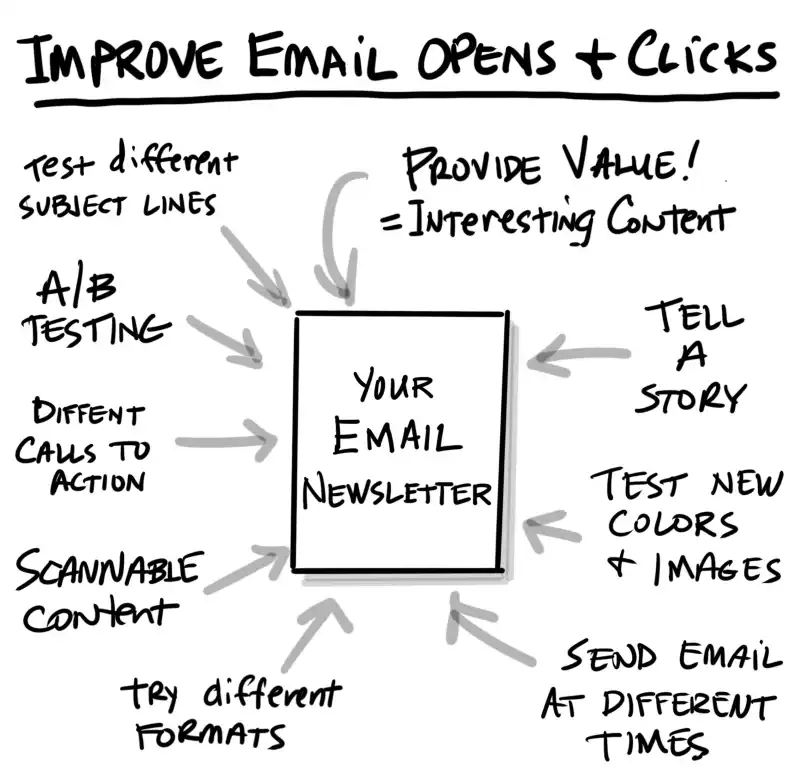How To Easily Improve Email Newsletter Engagement and Clicks With These Strategies
Updated on January 4, 2025 by Tim Donahue
Get more clicks – learn how to improve email newsletter engagement with these tips and strategies
If you’re wondering how to improve email newsletter engagement and clicks, you’re not alone. It’s a common challenge many businesses face. But don’t worry, it’s not as difficult as it might seem.
With a few strategic tweaks, you can transform your email newsletters into an engagement powerhouse. So, let’s jump into the nitty-gritty of it.
Understanding the Importance of Email Newsletters
Email newsletters aren’t just about sending information. They’re a powerful tool for driving engagement and clicks to your website.
When optimized, they can significantly boost your business’s visibility, customer loyalty, and, ultimately, sales.
Email newsletters are a cost-effective way to keep your audience informed about your business, promote products or services, and maintain customer relationships.
They can also be a gold mine for website traffic if your readers are incentivized to click through to your site.
Yet, many companies struggle with low open rates, fewer clicks, and overall poor engagement. It’s not because they’re doing something drastically wrong. Often, it’s a matter of small adjustments that make a big difference.
Here’s how to improve email newsletter engagement and clicks.

How to Improve Email Newsletter Engagement and Clicks: The Strategies
First a list of simple strategies to try and test for increasing clicks and engagement:
Simple Strategies to Improve Email Newsletter Engagement and Clicks
Here are some actionable strategies that you can implement today to improve your email newsletter engagement and click rates:
- Test Different Subject Lines: Your subject line is the first thing your subscribers see. Experiment with different tones, lengths, and styles to see what your audience responds to best. (More on this topic below!)
- Experiment with Calls to Action (CTAs): The placement, color, size, and label of your CTA button can all impact click-through rates. Don’t be afraid to try different variations to find what works best for your audience.
- Try Different Formats: A newsletter doesn’t have to be a wall of text. Break it up with bullet points, images, and headers. Test different formats to see what your audience prefers.
- Make your content scannable: People don’t like to read and in this fast-paced world, we mainly SCAN content for tidbits that are relevant.
- Tell A Story: Stories are a great way to engage readers because we all understand the format of hero, problem, solution, resolution.
- Personalize Your Emails: Personalization isn’t just about using your subscriber’s name in the email. It’s about providing content that is relevant to them. Segment your email list and tailor your content to each group.
- Test Email Frequency: How often you send emails can also impact engagement. Some audiences might prefer a monthly newsletter, while others might engage more with a weekly update.
Remember, improving email engagement isn’t a one-size-fits-all approach. It’s about understanding your audience, testing different strategies, and adapting based on the results.
How to test and improve your strategies
Now that you know what to try, let’s discuss how you can test these strategies and measure their success. This is where A/B testing comes in handy.
With A/B testing, you send two versions of your email to small, separate portions of your audience to see which performs better.
Once you’ve identified the more successful strategy, you can send the winning email to the rest of your audience. This method allows you to continually improve and refine your email strategy based on real, data-driven feedback.
For a more detailed guide on how to conduct A/B testing, you can refer to our blog post: Email Marketing: A Beginner’s Guide.
Improving your email newsletter engagement and clicks won’t happen overnight, but with patience, testing, and a commitment to understanding your audience, you’ll see improvement over time.
Mastering the Art of Email Headlines
One of the most critical aspects of your email newsletter is the headline. It’s the first thing your readers see and can significantly influence whether they open your email or ignore it.
Here, we’ll explore why headlines are essential and how to create compelling ones for your newsletters.
- Understand the Importance of Headlines: Your headline sets the tone for your entire email. It’s a sneak peek of what’s inside, and it’s often the deciding factor between an email being opened or left unread.With so many emails flooding our inboxes daily, a compelling headline can make your email stand out from the rest.
- Use Action Words: Action words encourage your readers to do something—they drive engagement.For example, instead of “Our new product line,” consider “Discover our exciting new product line.” The action word “Discover” adds energy and encourages the reader to click.
- Leverage Psychology: Understanding your audience’s psychology can significantly improve your headlines.For instance, using numbers (like “5 ways to improve your marketing strategy”) creates a sense of organization and can be more engaging. Additionally, creating a sense of urgency or scarcity (“Limited offer: Get it before it’s gone!”) can also prompt readers to open your emails.
- Keep It Short and Sweet: With more people checking emails on mobile devices, space is limited. Aim to keep your headlines under 50 characters so they don’t get cut off. Brevity forces clarity and can often result in more engaging headlines.
- Personalize When Possible: If you can personalize your email headlines, do it. People are more likely to respond to an email that appears to have been written just for them. For example, “John, we thought you might like these new books.”
Here are some example headlines that incorporate these principles:
- “Unlock your productivity with our top 5 tips”
- “Jane, see what’s new in your city this week”
- “Limited time offer: Save 50% on your next order”
- “Boost your skills with our free webinar”
- “Don’t miss out: Your exclusive invite inside”
Remember, the key to a great email headline is understanding your audience. Test different headline strategies, analyze the results, and continually refine your approach. Your email headlines will improve with time and practice, leading to higher open rates and better engagement.
More email engagement strategies and concepts:
- Create Engaging ContentFirst things first: you need to provide value.
This means creating content that your readers find interesting, useful, or entertaining. If your email newsletter is purely promotional, it won’t resonate. For instance, instead of just promoting your products, share helpful tips, industry news, or behind-the-scenes insights.
This will make your audience more likely to engage with your content and click on your links. For more on this, check out our post on content of value.
- Use A/B TestingDon’t just assume what works—test it. A/B testing can be invaluable in improving email newsletter engagement and clicks.
The term A/B testing comes from the idea of “Do they like A? or B?” ..and it’s the most commonly used strategy used in marketing to help marketers understand which option the customers respond to.
Test different subject lines, content formats, images, call-to-action (CTA) placements, and more. The goal is to understand what your audience responds to best.
For example, you might find that a certain type of subject line leads to higher open rates, or a specific CTA placement encourages more clicks. Remember, small changes can have a big impact.
- Segment Your AudienceNot all your subscribers are the same. So, why send them the same email? Segmenting your audience allows you to tailor your newsletters to different groups based on their interests, behaviors, or demographics.
This personalized approach can significantly boost engagement and clicks. For instance, if you’re a clothing retailer, you might send different newsletters to men and women or to customers interested in different product categories.
- Optimize for MobileDid you know that over half of all emails are opened on mobile devices? If your newsletter isn’t mobile-friendly, you’re missing out on potential engagement and clicks.
Make sure your design is responsive, your text is readable, and your buttons are easy to click on a small screen. For more information on this, read our post on how to create a successful ecommerce business.
Use the Power of Personalization
Let’s turn our attention to the potent effect of personalization. By addressing your subscribers directly by name, you can foster a stronger connection, making them feel valued and appreciated.
Most email service providers have features that allow you to include subscriber’s first names in the subject line and body of the email. When subscribers see their names, they are more likely to open your emails, which translates to increased engagement and click-through rates.
Take-away:
Personalization can be a game-changer in your quest for how to improve email newsletter engagement and clicks. It involves incorporating your subscriber’s name into the content of your email newsletters, fostering a sense of connection and appreciation that can boost open rates and click-throughs.
Make Your Content Relevant and Value-Packed
Content is king, even in email newsletters. Ensure that the content you share is not only relevant to your subscribers but also packed with value.
For instance, if you run a fitness blog, you can send out a weekly newsletter with expert tips on maintaining a healthy lifestyle, links to your recent blog posts, and discounts on fitness products.
This approach not only provides value to your subscribers but also promotes your offerings without sounding too salesy. And if you need further guidance on creating value-packed content, check out our post on the content of value and why it’s critical.
Take-away:
Making your content relevant and value-packed is a proven strategy for improving email newsletter engagement and clicks. By sharing pertinent information and value-adding content, you can enhance the appeal of your newsletters and encourage more clicks.
Utilize A/B Testing
A/B testing, also known as split testing, is a valuable tool in refining your email newsletter strategy. It involves testing two versions of your email to see which performs better.
You might test different subject lines, email layouts, or call-to-action phrases. By comparing the engagement levels of the two versions, you can gain insight into what resonates with your audience and refine your approach accordingly.
For more information on A/B testing, refer to our Comprehensive Guide on Marketing Basics.
Take-away:
A/B testing is an efficient way to learn what works best for your audience. By comparing two versions of your email newsletter and evaluating their performance, you can uncover effective strategies and improve your email engagement and clicks.
Conclusion
There you have it – the keys to improving your email newsletter engagement and clicks. By implementing these strategies, you’ll not only keep your subscribers engaged but also drive more traffic to your website or online store.
Remember, the goal isn’t to bombard your subscribers with emails, but rather to provide them with valuable content that they look forward to reading.
And don’t forget, this isn’t a one-size-fits-all approach. Continually test and refine your strategies to see what works best for your audience.
Happy emailing!
